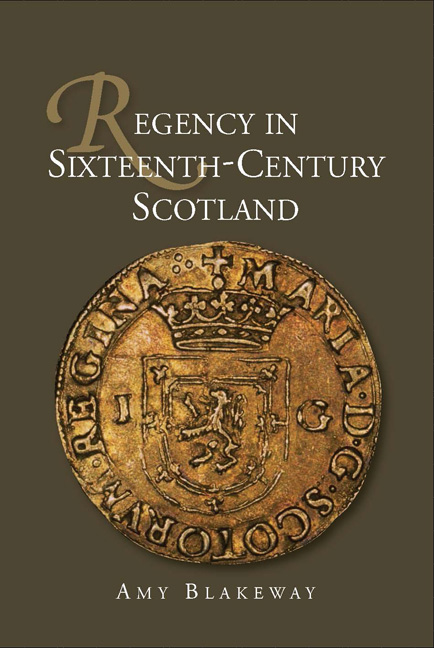Book contents
- Frontmatter
- Dedication
- Contents
- List of Figures and Tables
- Acknowledgements
- List of Abbreviations
- Timeline of Regents and Monarchs
- Introduction
- 1 Concepts of Regency
- 2 Concepts of Regency in Practice
- 3 Regency Finances
- 4 Households and Courts
- 5 Justice and Regency
- 6 Regency Diplomacy
- Conclusion
- Appendix 1 The Treasurer's Accounts
- Appendix 2 The Comptroller's Accounts
- Appendix 3 The Collectors of the Thirds' Accounts
- Appendix 4 Justice Ayres in Sixteenth-Century Scotland
- Bibliography
- Index
Conclusion
Published online by Cambridge University Press: 05 May 2015
- Frontmatter
- Dedication
- Contents
- List of Figures and Tables
- Acknowledgements
- List of Abbreviations
- Timeline of Regents and Monarchs
- Introduction
- 1 Concepts of Regency
- 2 Concepts of Regency in Practice
- 3 Regency Finances
- 4 Households and Courts
- 5 Justice and Regency
- 6 Regency Diplomacy
- Conclusion
- Appendix 1 The Treasurer's Accounts
- Appendix 2 The Comptroller's Accounts
- Appendix 3 The Collectors of the Thirds' Accounts
- Appendix 4 Justice Ayres in Sixteenth-Century Scotland
- Bibliography
- Index
Summary
These Inconvenients make that it is hard aneuch for any man to live in security in Scotland during the minority of a prince …
Any hereditary monarchy in which the succession is strictly determined by primogeniture faces the prospect of a child as head of state. As we have seen, sixteenth-century Scots experienced royal minority to a far greater degree than any of their European counterparts. Moreover, they coped with the ensuing ‘inconvenients’ in a strikingly uniform way: the appointment, succession or election of an individual to become regent, an office which comprised ‘bearing the person’ of the monarch. Throughout this book numerous contemporary quotations refer to regents, with the exceptions of the two dowager queens, as ‘princes’. In some cases, such as for Albany, Arran and Moray, this title appeared in the official parliamentary record; in other instances, it emerged in informal usage. Both are revealing: by identifying regents as ‘princes’ Scots acknowledged that they were set apart from the rest of the nobility by a special set of responsibilities and privileges. Nevertheless, the title of ‘prince’ is largely absent from modern discussion of regents, and with it, the connotations of quasi-monarchical rule encompassing a sense of continuity in central governmental activities have been lost.
This book has advanced two main arguments. The first is to propose a new, historical, model of regency to replace previous static, legalistic, interpretations of the office. Understandings of regency developed during the sixteenth century. At the start of the century, the Scots selected their regents as they had done for centuries: either the dead monarch left a testament appointing a regent, or, when such provisions failed, by identifying and installing the infant monarch's heir apparent. The precedents for the estates' involvement comprised either in confirming or identifying the correct candidate for the regency on these terms, or, as happened in the final years of David II's minority, in the last resort choosing a regent.
- Type
- Chapter
- Information
- Regency in Sixteenth-Century Scotland , pp. 233 - 239Publisher: Boydell & BrewerPrint publication year: 2015



